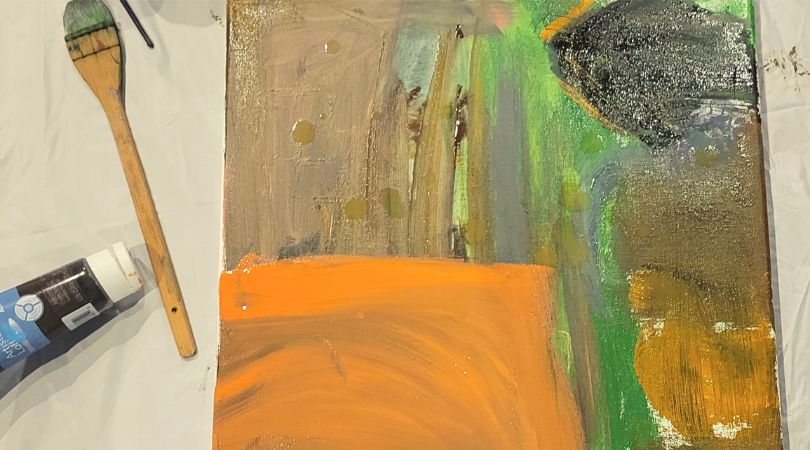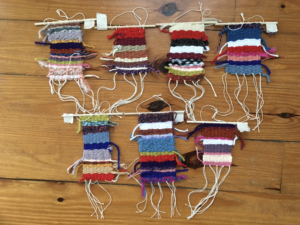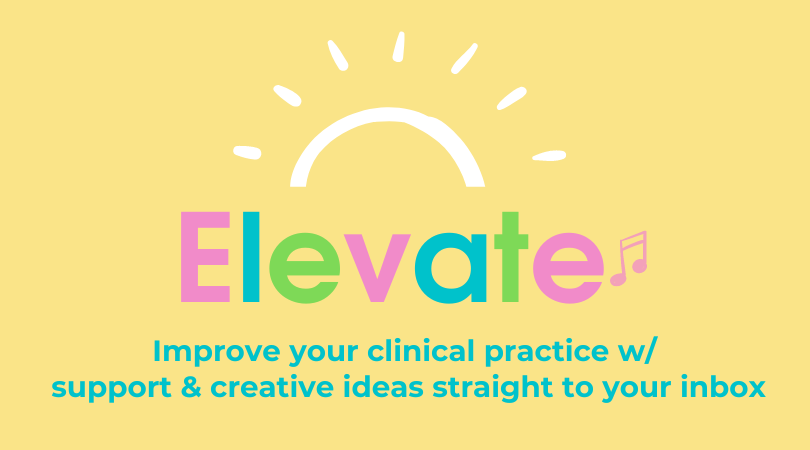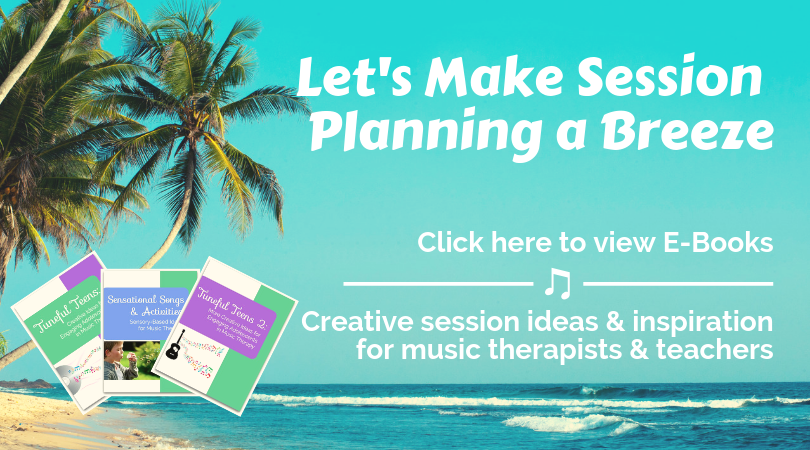
Last month, I started a series on successful Creative Arts Therapy Collaborations.
You can check out Part 1 of the series here, where I shared ways to incorporate dance and art experiences into your music therapy sessions (for example, by pretending to surf to songs by The Beach Boys and doing chalk drawings of outer space to The Planets Suite by Holst).
Today, I’m going to share some themes and experiences from an 8-week Healing Arts Program I facilitated for a high school autistic support classroom here in Pennsylvania.
I will start by saying I have never been a part of an experience like this before. It is one that truly stretched me creatively (and after 16 years of being a music therapist, I love things that keep me on my toes clinically!)
I had the opportunity to collaborate and co-treat with painters, fiber artists, yoga instructors, theatre instructors, and creative writers.
Prior to session planning, I met with the autistic support teacher, and she gave me several themes and concepts that she and her students were working on in the classroom.
From that list, I came up with a theme for each week’s hour and a half long session and collaborated with the instructor for that week to come up with our arts experiences.
Here are the themes and arts experiences we came up with for the first four weeks of the program:
Week 1 – Social skills
Theme – Making new friends, keeping our friendships, and how to be a good friend to others
Guest Arts Instructor – Painter
Arts Experiences:
- Group Round – Each student chose an instrument from the bag, played how they felt that morning, and the other students in the group tried to guess the feeling.
- Movement to the instrumental track of “Good Day” by Nappy Roots. Each student came up with their own movement to teach others.
- Songwriting – “The Friendship Rap,” about ways to make and keep friends
- Instrument call and response to tracks from the African Playground album. Students took turns being the leader. After, we discussed what we needed to do in order to successfully lead the group. We then related that to everyday life.
- Rotating Art – We played music chosen by the students. Each student then stood in front of a canvas on the table in front of them. They painted for several minutes, and then everyone rotated to the canvas to the right. The students then painted on that canvas and continued rotating until they had painted on each canvas.
Week 2 – Emotions
Theme – Recognizing emotions in ourselves and in others, and discussing why this is important.
Guest Arts Instructor – Musician
Arts Experiences:
- Group Round – Each student chose a song from a list I provided that best described how they’re feeling that morning.
- Group Movement to music
- Instruments & Emotions – Each student chose an emotion from the drum and played it on the instrument of their choice. Others then tried to guess the emotion and the group discussed times they’ve felt that way.
- Singing the original song “Let’s Stay in the Green Zone” with fill in the blank lyrics about ways they can stay in the green zone.
- Identifying Emotions in Music – Students used a variety of art materials (colored pencils, pastels) to draw to Beethoven’s Pastorale. Afterwards, we discussed what was being depicted in the music and what it feels like to draw like this. Then, students compared the Hallelujah Chorus to Adagio for Strings. We discussed the musical qualities that make a song “sound” happy or sad, and discussed how music can induce a mood.
- Lyric Analysis & Song Discussion to “Empathy Song” by Brett Dennen
- Drum Circle
Week 3 & 4 – Creativity
Theme – Exploring healthy creative outlets
Guest Arts Instructor – Fiber Artist
Arts Experiences:
- Movement to “AOK” by Tai Verdes and discussion of the positive impact movement and music have on our body and brain.
- Soundtrack of Your Life – Students created a soundtrack of their life with songs that have been meaningful to them. Afterwards, students who felt comfortable shared their soundtrack.
- Weaving Loom Project:

I also started and ended each session with a check in survey (on paper) to see how the students were feeling going into the session and how they felt after the session was complete (to see if any improvement in mood or decrease in feelings of stress had taken place).
I also asked their musical preferences, favorite experiences we had done that day, and what they would like to do in future sessions.
Whew that was a lot of info! Stay tuned for the next blog post, where I share the themes and arts experiences for the second half of the Healing Arts Program.
And, if you’re looking for ways to infuse more CREATIVITY in your sessions, I would encourage you to sign up for a 6-month subscription of Elevate.
You’ll receive monthly musical experience ideas sent straight to your inbox each month, have access to instructor support for any questions, AND complete Creativity Worksheets to double or triple the number of ideas you walk away with and earn 7 CMTE credits.
Choose from the Teen Package, the Attention & Perception Package, or grab the Combo Pack!




[…] at our local high school. These sessions are part of the Healing Arts Program I wrote about here, here, and here (check out these posts for TONS of creative arts therapy […]